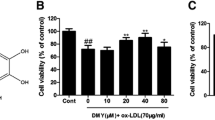Abstract
Objective
To investigate the role of aqueous extracts of Tribulus terrestris (TT) against oxidized low-density lipoprotein (ox-LDL)-induced human umbilical vein endothelial cells (HUVECs) dysfunction in vitro.
Methods
HUVECs were pre-incubated for 60 min with TT (30 and 3 μg/mL respectively) or 10-5 mol/L valsartan (as positive controls) and then the injured endothelium model was established by applying 100 μg/mL ox-LDL for 24 h. Cell viability of HUVECs was observed by real-time cell electronic sensing assay and apoptosis rate by Annexin V/PI staining. The cell migration assay was performed with a transwell insert system. Cytoskeleton remodeling was observed by immunofluorescence assay. The content of endothelial nitric oxide synthase (eNOS) was measured by enzyme-linked immunosorbent assay. Intracellular reactive oxygen species (ROS) generation was assessed by immunofluorescence and flow cytometer. Key genes associated with the metabolism of ox-LDL were chosen for quantitative real-time polymerase chain reaction to explore the possible mechanism of TT against oxidized LDL-induced endothelial dysfunction.
Results
TT suppressed ox-LDL-induced HUVEC proliferation and apoptosis rates significantly (41.1% and 43.5% after treatment for 3 and 38 h, respectively; P<0.05). It also prolonged the HUVEC survival time and postponed the cell's decaying stage (from the 69th h to over 100 h). According to the immunofluorescence and transwell insert system assay, TT improved the endothelial cytoskeletal network, and vinculin expression and increased cell migration. Additionally, TT regulated of the synthesis of endothelial nitric oxide synthase and generation of intracellular reactive oxygen species (P<0.05). Both 30 and 3 μg/mL TT demonstrated similar efficacy to valsartan. TT normalized the increased mRNA expression of PI3Kα and Socs3. It also decreased mRNA expression of Akt1, AMPKα1, JAK2, LepR and STAT3 induced by ox-LDL. The most notable changes were JAK2, LepR, PI3Kα, Socs3 and STAT3.
Conclusions
TT demonstrated potential lowering lipid benefits, anti-hypertension and endothelial protective effects. It also suggested that the JAK2/STAT3 and/or PI3K/AKT pathway might be a very important pathway which was involved in the pharmacological mechanism of TT as the vascular protective agent.
Similar content being viewed by others
References
Schächinger V, Britten MB, Zeiher AM. Prognostic impact of coronary vasodilator dysfunction on adverse longterm outcome of coronary heart disease. Circulation 2000;101:1899–1906.
Bugiardini R, Manfrini O, Pizzi C, Fontana F, Morgagni G. Endothelial function predicts future development of coronary artery disease: a study of women with chest pain and normal coronary angiograms. Circulation 2004;109:2518–2523.
Liu S, Shen H, Xu M, Liu O, Zhao L, Guo Z, Du J. FRP inhibits ox-LDL-induced endothelial cell apoptosis through an Akt-NF-kappaB-Bcl-2 pathway and inhibits endothelial cell apoptosis in an apoE-knockout mouse model. Am J Physiol Endocrinol Metab 2010;299:E351–363.
Monika S, Susanne HK. Phytochemicals in fruit and vegetables: health promotion and postharvest elicitors. Crit Rev Plant Sci 2006;25:267–278.
Hempel SL, Buettner GR, O'Malley YQ, Wessels DA, Flaherty DM. Dihydrofluorescein diacetate is superior for detecting intracellular oxidants: comparison with 2',7'-dic hlorodihydrofluorescein diacetate, 5(and 6)-carboxy-2',7'- dichlorodihydrofluorescein diacetate, and dihydrorhodamine 123. Free Radic Biol Med 1999;27: 146–159.
Chang L, and Karin M. Mammalian MAP kinase signalling cascades. Nature 2001;410(6824):37–40.
Yamamoto K, Hamada H, Shinkai H, Kohno Y, Koseki H, Aoe T. The KDEL receptor modulates the endoplasmic reticulum stress response through mitogen-activated protein kinase signaling cascades. J Biol Chem 2003;278:34525–34532.
Mehta D1, Malik AB. Signaling mechanisms regulating endothelial permeability. Physiol Rev 2006;86:279–367.
Izard T, Evans G, Borgon RA, Rush CL, Bricogne G, Bois PR. Vinculin activation by talin through helical bundle conversion. Nature 2004;427:171–175.
Thannickal VJ, Fanburg BL. Reactive oxygen species in cell signaling. Am J Physiol: Lung Cell Molecul Physiol 2000;279:L1005–L1028.
Shaul PW. Endothelial nitric oxide synthase, caveolae and the development of atherosclerosis. J Physiol 2003;547:21–33.
Bolz SS, Vogel L, Sollinger D, Derwand R, de Wit C, Loirand G, et al. Nitric oxide-induced decrease in calcium sensitivity of resistance arteries is attributable to activation of the myosin light chain phosphatase and antagonized by the RhoA/Rho kinase pathway. Circulation 2003;107:3081–3087.
Author information
Authors and Affiliations
Corresponding author
Additional information
Supported by the Development Plan Project of Science and Technology of Shandong Province (No. 2014GSF119011) and Shandong Province 'Taishan Scholar' Construction Project (No. 2012-55)
Rights and permissions
About this article
Cite this article
Jiang, Yh., Yang, Ch., Li, W. et al. Aqueous extracts of Tribulus terrestris protects against oxidized low-density lipoprotein-induced endothelial dysfunction. Chin. J. Integr. Med. 22, 193–200 (2016). https://doi.org/10.1007/s11655-015-2321-0
Received:
Published:
Issue Date:
DOI: https://doi.org/10.1007/s11655-015-2321-0




